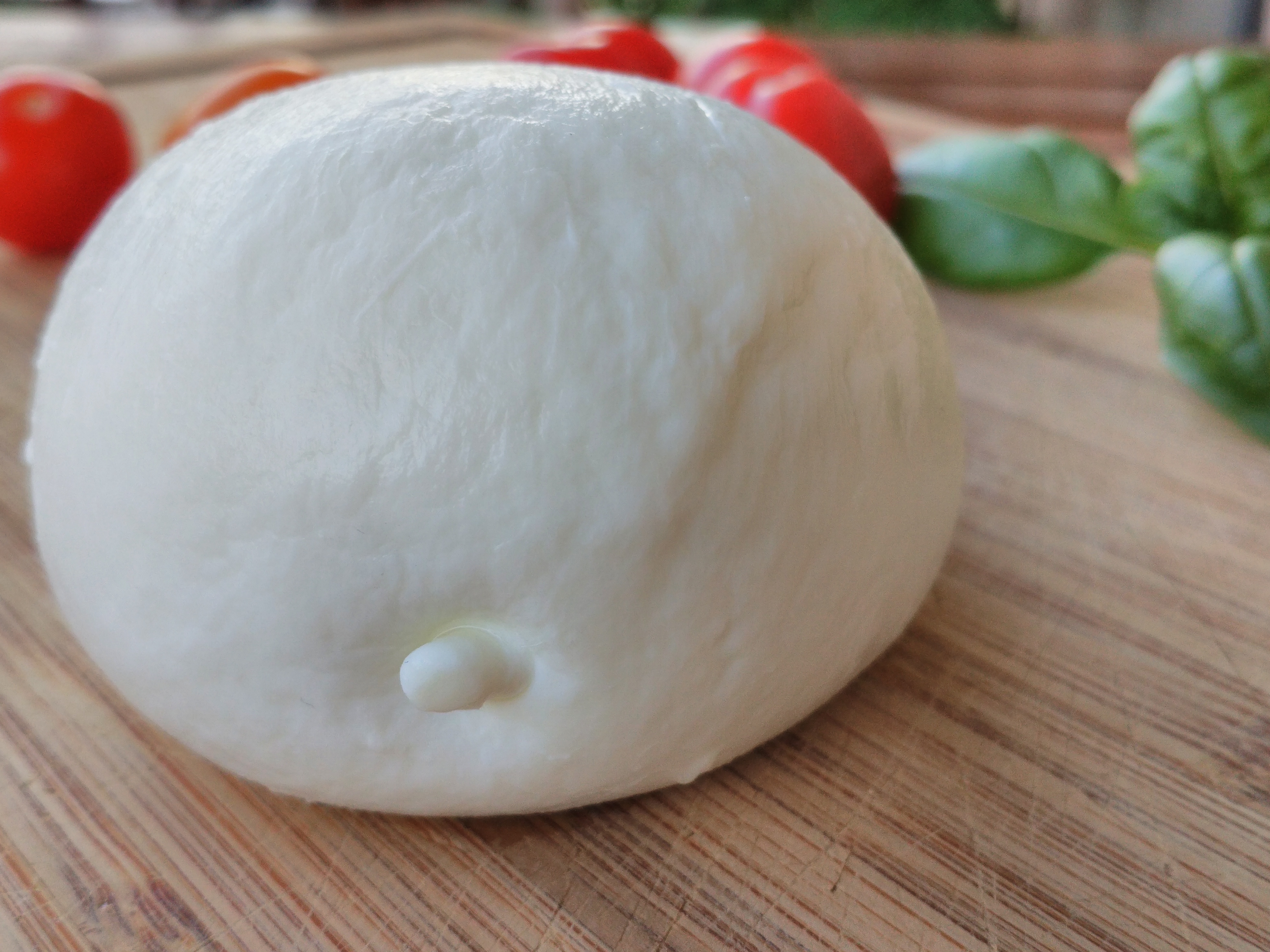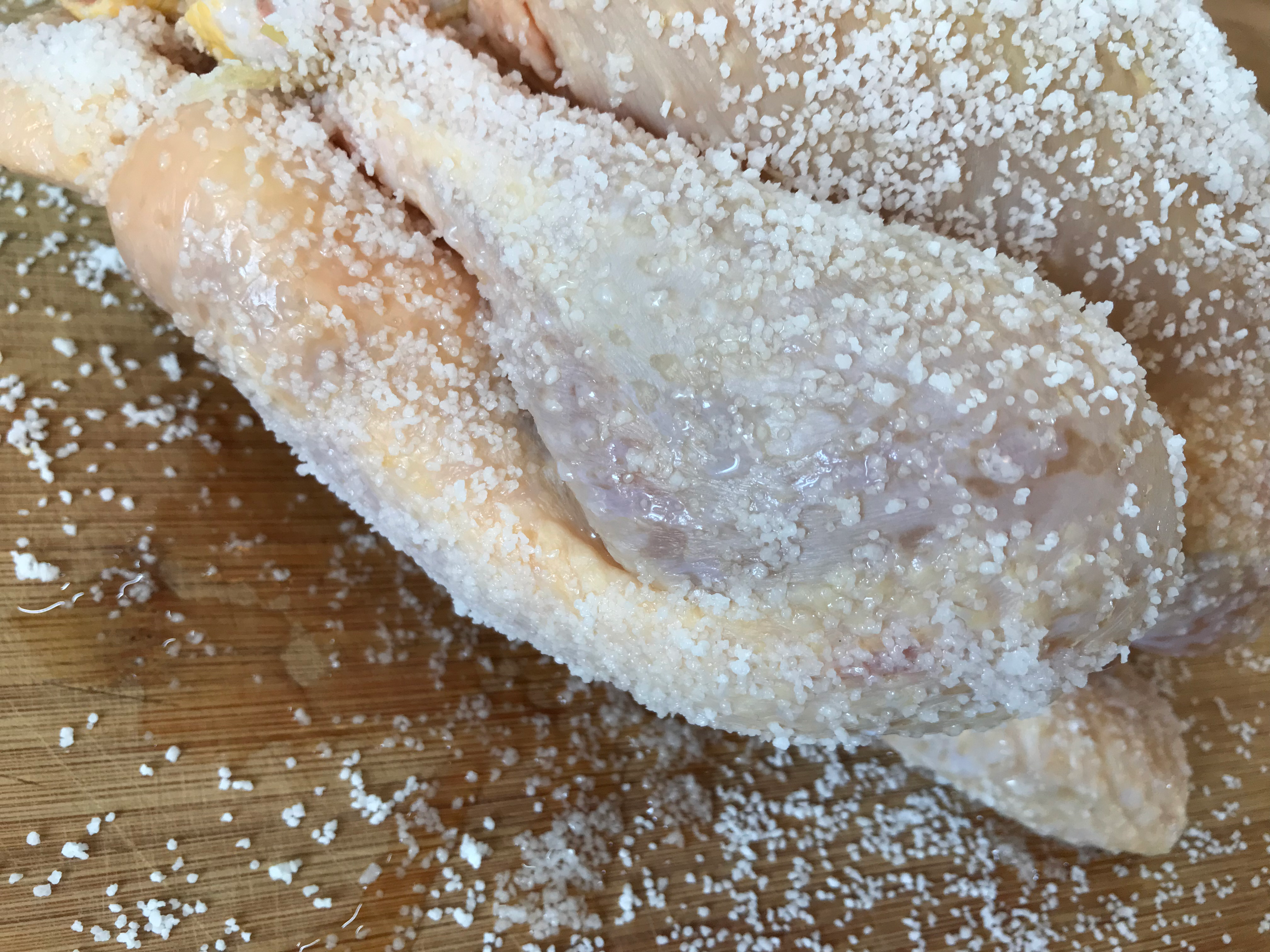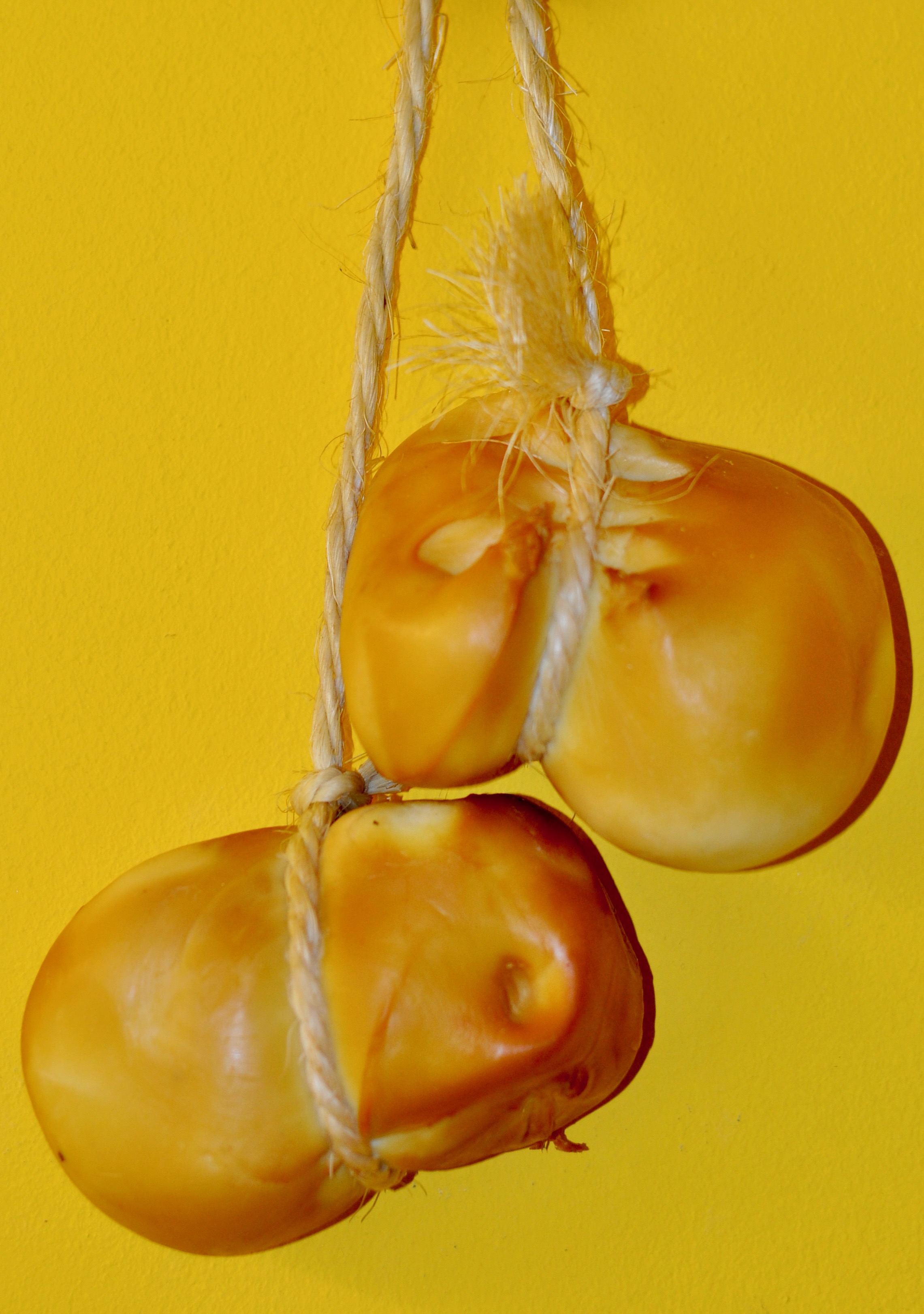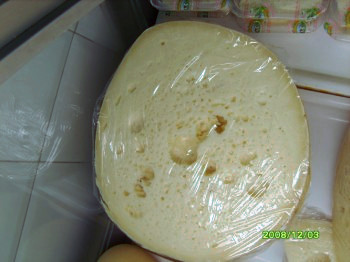|
Pasta Filata
(Italian: "spun paste") is a technique in the manufacture of a family of Italian cheeses also known in English as stretched-curd, pulled-curd, and plastic-curd cheeses. Stretched curd cheeses manufactured from the pasta filata technique undergo a plasticising and kneading treatment of the fresh curd in hot water, which gives the cheese its fibrous structure. The cheese-making begins in the normal way. The milk (usually from cows or water buffalo) is warmed and curdled and allowed to rest for an hour before the curds are cut into small pieces and the whey is drained off. The curds are allowed to rest for a number of hours. Then follows the , which is when the curds are steeped for some hours in a bath of very hot whey, or water (for the temperature is 95 °C). Once they begin to float, most of the liquid is removed and the curd is mixed and kneaded until the required soft, elastic, stringy texture is obtained. The mass of curd is divided (often by pulling out a thick strand ... [...More Info...] [...Related Items...] OR: [Wikipedia] [Google] [Baidu] |
Mozzarella Di Bufala3
Mozzarella (, ; nap, muzzarella ) is a southern Italian cheese traditionally made from Italian buffalo's milk by the pasta filata method. Fresh mozzarella is generally white but when seasoned it turns to a light yellow depending on the animal's diet. Due to its high moisture content, it is traditionally served the day after it is made but can be kept in brine for up to a week or longer when sold in vacuum-sealed packages. Low-moisture mozzarella can be kept refrigerated for up to a month, though some shredded low-moisture mozzarella is sold with a shelf life of up to six months. Mozzarella is used for most types of pizza and several pasta dishes or served with sliced tomatoes and basil in Caprese salad. Etymology ''Mozzarella'', derived from the Southern Italian dialects spoken in Apulia, Calabria, Campania, Abruzzo, Molise, Basilicata, Lazio, and Marche, is the diminutive form of ("cut"), or ("to cut off") derived from the method of working. The term is first men ... [...More Info...] [...Related Items...] OR: [Wikipedia] [Google] [Baidu] |
Provolone
Provolone (, ) is an Italian cheese. It is an aged ''pasta filata'' (stretched-curd) cheese originating in Campania near Vesuvius, where it is still produced in pear, sausage, or cone shapes long. Provolone-type cheeses are also produced in other countries. The most important provolone production region today is Northwestern Italy and the city of Cremona. Provolone, provola, and provoleta are versions of the same basic cheese. Some versions of provolone are smoked. p. 165. History and varieties The term ''provolone'' (meaning "large provola") appeared around the end of the 19th century, when it started to be manufactured in the southern regions of Italy and assumed its current large size. The smaller sized variant is called pro ...[...More Info...] [...Related Items...] OR: [Wikipedia] [Google] [Baidu] |
Smoking (cooking)
Smoking is the process of flavoring, browning, cooking, or preserving food by exposing it to smoke from burning or smoldering material, most often wood. Meat, fish, and ''lapsang souchong'' tea are often smoked. In Europe, alder is the traditional smoking wood, but oak is more often used now, and beech to a lesser extent. In North America, hickory, mesquite, oak, pecan, alder, maple, and fruit-tree woods, such as apple, cherry, and plum, are commonly used for smoking. Other biomass besides wood can also be employed, sometimes with the addition of flavoring ingredients. Chinese tea-smoking uses a mixture of uncooked rice, sugar, and tea, heated at the base of a wok. Some North American ham and bacon makers smoke their products over burning corncobs. Peat is burned to dry and smoke the barley malt used to make Scotch whisky and some beers. In New Zealand, sawdust from the native manuka (tea tree) is commonly used for hot smoking fish. In Iceland, dried sheep dung is used ... [...More Info...] [...Related Items...] OR: [Wikipedia] [Google] [Baidu] |
Brining
In food processing, brining is treating food with brine or coarse salt which preserves and seasons the food while enhancing tenderness and flavor with additions such as herbs, spices, sugar, caramel or vinegar. Meat and fish are typically brined for less than twenty-four hours while vegetables, cheeses and fruit are brined in a much longer process known as pickling. Brining is similar to marination, except that a marinade usually includes a significant amount of acid, such as vinegar or citrus juice. Brining is also similar to curing, which usually involves significantly drying the food, and is done over a much longer time period. Meat Brining is typically a process in which meat is soaked in a salt water solution similar to marination before cooking. Meat is soaked anywhere from 30 minutes to several days. The amount of time needed to brine depends on the size of the meat: more time is needed for a large turkey compared to a broiler fryer chicken. Similarly, a large roast must ... [...More Info...] [...Related Items...] OR: [Wikipedia] [Google] [Baidu] |
Aging (food)
Aging (American English) or ageing (British English), in the context of food or beverages, is the leaving of a Product (business), product over an extended period of time (often months or years) to aid in improving the Flavoring, flavor of the product. Aging can be done under a number of conditions, and for a number of reasons including stronger umami flavors and tenderness. Drying Food drying, Drying of foods by leaving them in a low-humidity environment has been used as a food preservation technique for millennia. Air-dried meat such as jerky may have been some of the first preserved foods ever eaten by man. Drying also concentrates flavors in foods by removing water from them. Fermentation Foods may be aged to allow fermentation to occur, such as in the making of alcoholic beverages, in cheesemaking, in pickling, such as kimchi, and in meat or fish products such as fermented sausage or surströmming. Culturing Besides fermentation, microbial food cultures can act on fo ... [...More Info...] [...Related Items...] OR: [Wikipedia] [Google] [Baidu] |
Scamorza
Scamorza () is a Southern Italian cow's milk cheese. It can also be made from other milks, but that is less common. It is a stretched-curd cheese, in which the fresh curd matures in its own whey for several hours to allow acidity to develop through the conversion of lactose to lactic acid. Artisanal cheese makers generally form the cheese into a round shape, and then tie a string around the mass one third of the distance from the top, and hang it to dry. The resulting shape is pear-like. This is sometimes referred to as "strangling" the cheese. The cheese is usually white unless smoked. When smoked, the color is almond with a lighter interior. Scamorza can be substituted for mozzarella in most dishes, but the resulting taste will be much stronger and more dominant. It is reputed to melt better in baking. Using the smoked variety () adds a prominent background flavor in replacement of mozzarella. Etymology The term may come from the Italian phrases or , both meaning "severed ... [...More Info...] [...Related Items...] OR: [Wikipedia] [Google] [Baidu] |
Pallone Di Gravina
The Pallone di Gravina is a firm, semi-hard, cow's milk cheese from the regions of Basilicata and Apulia in south-east Italy. It is made in the ''pasta filata'' style weighing between , in a pear-like shape, ball or balloon (''pallone''), and was traditionally produced in the area of the city of Gravina, in the Murgia area of the province of Bari. Today, however, production is centred on the province of Matera. In 2016 the comune of Gravina made an application for the cheese to receive PDO status within the European Union. In 2012 has been recognized as Slow Food Presidia, from Slow Food International organization, thanks to the work made by Mr. Antonio Cucco Fiore, MBA. Description The rind is hard, smooth and straw-coloured, becoming browner with age; the body, firm in texture, and also starts out straw-yellow, but turns golden as the cheese matures. Pallone di Gravina is at its best after being aged for at least twelve months. [...More Info...] [...Related Items...] OR: [Wikipedia] [Google] [Baidu] |
Caciocavallo Silano
Caciocavallo is a type of stretched-curd cheese made out of sheep's or cow's milk. It is produced throughout Southern Italy, particularly in the Apennine Mountains and in the Gargano peninsula. Shaped like a teardrop, it is similar in taste to the aged Southern Italian Provolone cheese, with a hard edible rind. Etymology The Italian name of the cheese ''caciocavallo'' literally means "horse cheese" and it is generally thought that the name derives from the fact that two cheese forms are always bound together with rope and then left to mature by placing them 'a cavallo', i.e. straddling, upon a horizontal stick or branch. History Apparently caciocavallo was mentioned the first time around 500 BC by Hippocrates, emphasising the "Greeks' cleverness in making cheese". Columella in his classic treatise on agriculture, ''De re rustica'' (35–45 CE), described precisely the methods used in its preparation, making it one of the oldest known cheeses in the world. Types of cheese wi ... [...More Info...] [...Related Items...] OR: [Wikipedia] [Google] [Baidu] |
Mozzarella
Mozzarella (, ; nap, muzzarella ) is a southern Italian cheese traditionally made from Italian buffalo's milk by the pasta filata method. Fresh mozzarella is generally white but when seasoned it turns to a light yellow depending on the animal's diet. Due to its high moisture content, it is traditionally served the day after it is made but can be kept in brine for up to a week or longer when sold in vacuum-sealed packages. Low-moisture mozzarella can be kept refrigerated for up to a month, though some shredded low-moisture mozzarella is sold with a shelf life of up to six months. Mozzarella is used for most types of pizza and several pasta dishes or served with sliced tomatoes and basil in Caprese salad. Etymology ''Mozzarella'', derived from the Southern Italian dialects spoken in Apulia, Calabria, Campania, Abruzzo, Molise, Basilicata, Lazio, and Marche, is the diminutive form of ("cut"), or ("to cut off") derived from the method of working. The term is first ment ... [...More Info...] [...Related Items...] OR: [Wikipedia] [Google] [Baidu] |
Italy
Italy ( it, Italia ), officially the Italian Republic, ) or the Republic of Italy, is a country in Southern Europe. It is located in the middle of the Mediterranean Sea, and its territory largely coincides with the homonymous geographical region. Italy is also considered part of Western Europe, and shares land borders with France, Switzerland, Austria, Slovenia and the enclaved microstates of Vatican City and San Marino. It has a territorial exclave in Switzerland, Campione. Italy covers an area of , with a population of over 60 million. It is the third-most populous member state of the European Union, the sixth-most populous country in Europe, and the tenth-largest country in the continent by land area. Italy's capital and largest city is Rome. Italy was the native place of many civilizations such as the Italic peoples and the Etruscans, while due to its central geographic location in Southern Europe and the Mediterranean, the country has also historically been home ... [...More Info...] [...Related Items...] OR: [Wikipedia] [Google] [Baidu] |
Whey
Whey is the liquid remaining after milk has been curdled and strained. It is a byproduct of the manufacturing of cheese or casein and has several commercial uses. Sweet whey is a byproduct resulting from the manufacture of rennet types of hard cheese, like cheddar or Swiss cheese. Acid whey (also known as sour whey) is a byproduct brought out during the making of acid types of dairy products, such as strained yogurt. Whey proteins consist of α-lactalbumin, β-lactoglobulin, serum albumin, immunoglobulins, and proteose peptones. Composition Whey protein is the collection of globular proteins isolated from whey. The protein in cow's milk is 20% whey protein and 80% casein protein, whereas the protein in human milk is 60% whey and 40% casein. The protein fraction in whey constitutes approximately 10% of the total dry solids in whey. This protein is typically a mixture of beta-lactoglobulin (~48-58%), alpha-lactalbumin (~13-19%), bovine serum albumin (~6%)(see also serum albumi ... [...More Info...] [...Related Items...] OR: [Wikipedia] [Google] [Baidu] |







